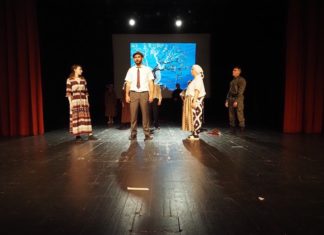Stéphane Laederich is the executive director of Rroma Foundation in Zürich. He has been working with Rroma community in Switzerland and Europe for the last twenty-five years. In September he participated in „The Second International Conference on the Genocide of the Rroma” during the Croatian IHRA presidency.
You are a mathematician and physician, IT finance specialist, and the director of the Rroma Foundation in Zürich. What is it that unites all your previous and actual professions and interests into one? And where did the motivation for dealing with Rroma issues come from?
First of all, I studied mathematics, then I worked for Rroma in Eastern Europe in the 90s, started working at the Rroma Foundation in ’97. We are a small foundation, so there is not much money to be earned. Actually, I’ve never been paid by the Foundation, so I had to find some other means to survive. My family grew among Rroma, I learned Rromanes, and eventually, I felt there was something that needed to be done.
A lot is said and written about the position of the Rroma in the DACH region, but most of it refers to Germany and Austria. How many Rroma live in Switzerland and how intense is anti-Roma racism in that country?
Let’s start with the anti-Roma racism in Switzerland. If you meet with government officials and they literally ask you if you know how to read and write, it tells you that there is progress to be made. The stereotypes are so ingrained in the population that they don’t even realize what racist statements they’re actually making. We tell journalists ‘Just replace the word ”Rrom” in your article with ”Jew” and ask yourself whether you would still publish it. ”All the Jews are…” – you would never write this. But ”All the Rroma are beggars” you can write.’ Racism is really profound. As a result, Rroma will not declare themselves at all in Switzerland.
Now, who are the Roma in Switzerland? First of all, you have quite a few Sinti and Manouche in the western part of Switzerland, and other Roma who came later: in the late 19th century Vlach Roma, in the early 20th century Roma from Poland, and so on. After World War I many Roma came as refugees. You also have Roma from mostly northeastern Europe – Poland, Czech Republic, etc. – who emigrated way before World War II.
And then, in the 1950s you have Gastarbeiter (guest workers). From Yugoslavia, you have a lot of guest workers. Just to give you an idea, right now there are about half a million people from former Yugoslavia in Switzerland who don’t have a Swiss passport yet. It’s more than 15% of the population. In former Yugoslavia, you had 10% of Roma and they were exactly as mobile as the rest of the population. So, we estimate that it’s probably around 100,000 Roma now living in Switzerland. Also, you had this influx of guest workers also from Spain, Portugal, from Yugoslavia, as I already mentioned, and then you had also the Yugoslav wars with the most notable impact on Kosovo Rroma where a lot of them came to Switzerland. I know quite a few because in the Foundation we defended about 2000 cases of families looking for asylum.
In the redaction of the magazine Phralipen, we follow the Rroma Foundation’s website Rroma.org. We are familiar with the fact that one of the focuses of the Foundation is media campaigns. In your opinion, what is important in this work and what is the state of the media in Switzerland when it comes to reporting on minorities, especially Rroma and Sinti minorities?
We focus on media because if you want to change people’s opinions, you really have to change the way journalists speak about the Rroma. When we did the first study on the Swiss German media, we really analyzed every single article published over a year. And then we sent the summary to the journalists who had written it and we invited them to a press conference. Only three journalists came. All the others were afraid of coming. The fact that they could be associated by name with racist statements in their articles that they had not even realized, was a shock to a lot of them.
You have to be very direct and face journalists with their own work so that they finally realize ‘Oh, maybe this is not exactly what we should be saying.’ That’s why we try to follow the press across quite a large number of languages. When you do the analyses and work with the journalists themselves, when you show them ‘Look, this is what has been written, your newspaper is writing this kind of crap’, you can go to court and you can start thinking about changing the situation. Actually, it’s very difficult to go to court in Switzerland – you lose most of the cases because judges say, for example, ‘It’s clear that all Rroma steal’, which tells you a lot about the state of racism in Switzerland.
All in all, our job has two sides: it is interesting to follow what’s happening and it’s also worrisome because you see the trends in other countries, like Bulgaria, in which they mostly report about the Rroma fights, drug dealing, etc. Generally, a broad media covering of the Rroma questions didn’t exist before. That’s an indication of how things are evolving.











